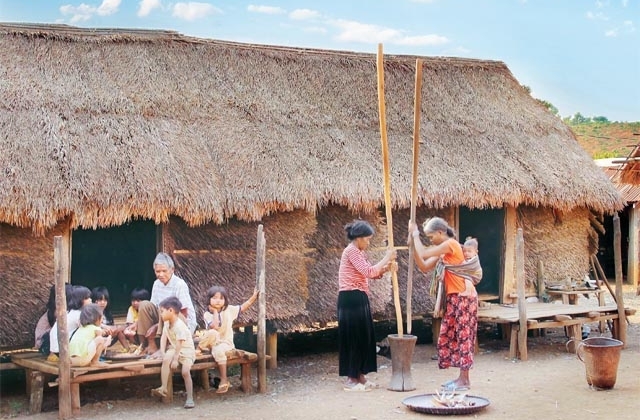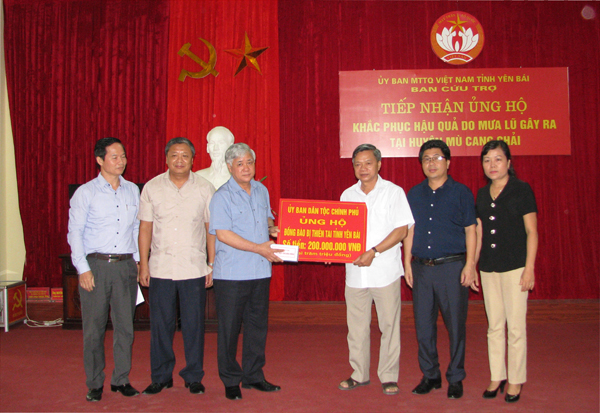Preserving Ma people’s long traditional houses
01:58 PM 25/07/2016 Views: 1496 PrintThe long house is a traditional architectural construction of indigenous ethnic groups in the southern Central Highlands region. It is also a reservatory of the traditional cultural identity of the locals. However, with the changing times, the role of the house is being disregarded and thus is facing the risk of falling into oblivion.
|
Tracing back the memory of the land In B’Dang village, Loc Bac commune, Bao Lam district, Lam Dong province survives the only remaining traditional long house of the Ma ethnic group. Even 63-year-old Ka Dit, the owner, cannot remember when the house was constructed. In her faded memory, she remembers it being there since the first day she became a member of her husband’s family. Many generations have lived here, never letting the flame go out in the house’s fire pits. Tracing back the past, Ka Dit recalled that there were around 60 long houses in the village, each between 50 and 60 metres and even up to 100 metres long, with 10 fire pits set up inside, which meant that 10 consanguineous families were living together in the house. When the family welcomed a new couple, they extended their home two or three metres in length to accommodate the new family. The houses gradually became longer throughout the generations. Ka Dit’s house is nearly 30 metres long, which is quite modest in comparison to other houses which were hundreds of metres in length as recorded by French people in the early 20th century. According to K’Tu, Chairman of Loc Bac commune People’s Committee, his maternal grandfather said in the past, the village had hundreds of people, all of them living in just several long houses. Along with gongs and jars of Can’ wine (wine drunk out of a jar via wooden bamboo pipes), the long houses play an important role in the spiritual life of Ma people. The three items must be present in every traditional ceremonial. For Ma people, the long house is a holy place where the god resides and antiques are kept to hand down to descendants, K’Tu said. More importantly, only in the house’s space, traditional rituals and customs of Ma people can be fully worshipped, he stressed. Elder K’Diep revealed that the long house not only provided a shelter for people and protected them from the nature and animals, but also helped connect generations together. There are no boundaries for the living spaces of families in the house. Despite living together, hardly any conflicts happened under the roof of the intergenerational house. Long houses – where the flame never goes out |
According to cultural researchers, Co Ho, Ma and Chu Ru people in Lam Dong province considered the number of long houses as one of the criteria for the “stature” of a village. But this is not applied in modern life any more.
When asked about the standard length to recognise a long house, Elder K’Diep was confused and said that a long house consists of many households while a short house has only one household living inside.
It was concluded that the measurement of a long house is not based on its length, but on the family living in that house.
Located amid B’Dang valley, Ka Dit’s long house has a wooden frame and bamboo-tiled floor under a thatched roof. A granary was constructed outside the house. Decorations inside the house are still kept intact.
A holy space in the house is called ‘Nao’, where the house’s god – Yang Hiu – is worshipped. There are also places for communal activities; a living room; kitchen; separated accommodations for adolescences, single men and male guests; single women and female guests as well as a space to store gongs, jars and traditional musical instruments.
In the centre of the house is a mha tom (shared kitchen), where family members gather for important celebrations.
In the past, at night fall, the family gathered around the flame of the fire pit, then the elders recited verses ofKhan (epics) for the descendants, shared their experiences of hunting and cultivation, or all joined together for the traditional ‘yal yau’ and ‘tam pot’ melodies.
The living spaces of households are arranged based on hierarchy. From the main entrance, it starts with the house’s owner, then his oldest son, and goes on. Each household has its own fire pit. One can tell the number of households living inside the house based on the number of fire pits.
Ka Dit said that fire is the soul of the long house. It is a god, and most of Ma people’s ceremonies and festivals start with the “asking for fire” ritual. When people are not cook in the kitchens, they still keep the charcoal under the ash so that the flame never goes out in the fire pit.
Long houses become shorter – determination for preservation
However, as time goes by, the modern lifestyle has reached every village of the commune. Younger families want to leave the long house to live their own life. K’Than, Ka Dit’s son, shared that living in the long house was inconvenient, so he decided to move out.
Therefore, Ka Dit’s long house became shorter, with only one fire pit still keeping its flame alight in the house.
Elder K’ Diep was concerned that unless we uphold the image of the long house, there would be no evidence of these ancient architectural constructions in the Central Highlands.
Chairman of Loc Bac commune People’s Committee, K’ Tu stressed the determination to rebuild a long house in the centre of the commune. “If we don’t do this, how can the younger generations know about the long house and the way their ancestors lived?”, he wondered.
Being aware of the long house’s value in preserving and promoting the fine traditions of indigenous people, Lam Dong provincial cultural sector has provided financial support to restore and repair these types of constructions in B’Dang village, Loc Bac commune.
Deputy director of the provincial Department of Culture, Sports and Tourism Nguyen Thi Bich Ngoc said that the locality would continue the aid while conducting surveys and field trips to help raise locals’ awareness of the importance of safeguarding their cultural identities.
In the long term, the province will work harder to seek proper solutions to restore and promote the role of the long houses, she added.
(Source:en.nhandan.com.vn)
54 ETHNIC GROUPS
THỐNG KÊ TRUY CẬP
Số lượt truy cập hiện tại: 9
Tổng số truy cập:




